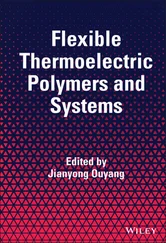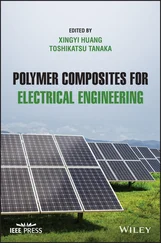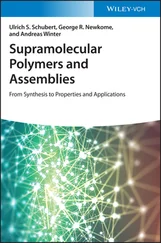Ming Qiu Zhang - Extrinsic and Intrinsic Approaches to Self-Healing Polymers and Polymer Composites
Здесь есть возможность читать онлайн «Ming Qiu Zhang - Extrinsic and Intrinsic Approaches to Self-Healing Polymers and Polymer Composites» — ознакомительный отрывок электронной книги совершенно бесплатно, а после прочтения отрывка купить полную версию. В некоторых случаях можно слушать аудио, скачать через торрент в формате fb2 и присутствует краткое содержание. Жанр: unrecognised, на английском языке. Описание произведения, (предисловие) а так же отзывы посетителей доступны на портале библиотеки ЛибКат.
- Название:Extrinsic and Intrinsic Approaches to Self-Healing Polymers and Polymer Composites
- Автор:
- Жанр:
- Год:неизвестен
- ISBN:нет данных
- Рейтинг книги:5 / 5. Голосов: 1
-
Избранное:Добавить в избранное
- Отзывы:
-
Ваша оценка:
- 100
- 1
- 2
- 3
- 4
- 5
Extrinsic and Intrinsic Approaches to Self-Healing Polymers and Polymer Composites: краткое содержание, описание и аннотация
Предлагаем к чтению аннотацию, описание, краткое содержание или предисловие (зависит от того, что написал сам автор книги «Extrinsic and Intrinsic Approaches to Self-Healing Polymers and Polymer Composites»). Если вы не нашли необходимую информацию о книге — напишите в комментариях, мы постараемся отыскать её.
Extrinsic and Intrinsic Approaches to Self-Healing Polymers and Polymer Composites,
Extrinsic and Intrinsic Approaches to Self-Healing Polymers and Polymer Composites
Extrinsic and Intrinsic Approaches to Self-Healing Polymers and Polymer Composites — читать онлайн ознакомительный отрывок
Ниже представлен текст книги, разбитый по страницам. Система сохранения места последней прочитанной страницы, позволяет с удобством читать онлайн бесплатно книгу «Extrinsic and Intrinsic Approaches to Self-Healing Polymers and Polymer Composites», без необходимости каждый раз заново искать на чём Вы остановились. Поставьте закладку, и сможете в любой момент перейти на страницу, на которой закончили чтение.
Интервал:
Закладка:
2 Chapter 2Figure 2.1 Schematic drawing of a self‐healing epoxy specimen with embedded ...Scheme 2.1 Chemical structure of PETMP.Scheme 2.2 Reaction schemes of melamine‐formaldehyde resins. (a) Formation o...Figure 2.2 DSC heating traces of (a) epoxy (DTP)/PETMP/BDMA = 10.9/8.7/1, (b...Figure 2.3 Effects of storage time and temperature on stability of PMF‐walle...Figure 2.4 Micro‐Raman spectra of (a) cured epoxy, (b) a raw DTP drop on cur...Figure 2.5 Effects of storage time and temperature on stability of PMF‐walle...Figure 2.6 (a) Expansibility and advantages of thermoplastic tubing in const...Figure 2.7 Optical microscopy photo taken from a self‐healing TDCB specimen,...Figure 2.8 Typical load–displacement curves recorded during TDCB tests. The ...Figure 2.9 Influence of capsule concentration on fracture toughness and heal...Figure 2.10 Time dependence of healing efficiency at different temperatures....Scheme 2.3 Reactions between epoxide and mercaptan catalyzed by tertiary ami...Figure 2.11 Influence of species and content of catalyst on healing efficien...Figure 2.12 Influence of combinations of epoxy and mercaptan on healing effi...Figure 2.13 Scanning electronic microscopy images of healed cracks near the ...Figure 2.14 Time dependences of fracture toughness (•) developed in healed s...Figure 2.15 Crack length vs. fatigue cycle of (a) neat epoxy specimen, (b) m...Figure 2.16 Crack length vs. fatigue cycles of (a) control specimen and (b) ...Figure 2.17 Crack length vs. fatigue cycles of (a) control specimen and (b) ...Figure 2.18 Healing efficiency of self‐healing specimens as a function of st...Figure 2.19 Crack length vs. fatigue cycles of self‐healing specimens. The a...Figure 2.20 Healing efficiency of self‐healing specimens with a rest period ...Figure 2.21 Healing efficiency of self‐healing specimens with a rest period ...Figure 2.22 Through‐scan mode ultrasonic images of the impacted self‐healing...Figure 2.23 SEM micrographs of the fractured surfaces of the self‐healing la...Figure 2.24 Experimental results of the orthographic factorial design.Figure 2.25 Non‐isothermal DSC scanning curves of the mixture of 100 parts D...Figure 2.26 Non‐isothermal DSC scanning curves of the mixture of 100 parts D...Figure 2.27 (a) Load–displacement curves and (b) flexural strengths of the c...Figure 2.28 Typical load–displacement curves of the composite laminates with...Figure 2.29 (a) Typical load–displacement curves recorded during indentation...Figure 2.30 (a) Sealed PP tubes containing the mixture of epoxy monomer DTHP...Figure 2.31 Typical fluorescence microscopy images (using an Axio Oberver Z1...Figure 2.32 Effect of (a) tube spacing and (b) foaming agent content on flex...Figure 2.33 Photos of the back surface of the composite laminates with the h...Figure 2.34 Fluorescent microscopy photos of the back face of the composite ...Figure 2.35 (a) Effect of healing time on flexural strength and healing effi...Figure 2.36 Through‐scan mode ultrasonic images of the indentation damaged c...Figure 2.37 Effect of room temperature storage time on flexural strength and...
3 Chapter 3Scheme 3.1 Curing of epoxy in the presence of (C 2H 5) 2O·BF 3.Figure 3.1 Design of the self‐healing PS.Scheme 3.2 Molecular structures of epoxy resins (EPON 828 and DTP), polymeri...Figure 3.2 Scanning electron microscopy photos of DTP‐loaded microcapsules [...Figure 3.3 Fourier transform infrared spectra of EPON 828, EPON 828‐loaded m...Figure 3.4 Scanning electron microscopy photos of DTP‐containing microcapsul...Figure 3.5 Size distribution of DTP‐containing microcapsules. Preparation co...Figure 3.6 Influence of different levels of the five factors (see Table 3.1)...Figure 3.7 Ultraviolet irradiation time dependence of microcapsule yield ini...Scheme 3.3 Photodecomposition of the initiators.Figure 3.8 Schematic drawing of (a) cross‐section of a piece of sisal leaf, ...Figure 3.9 Infiltration time dependence of the loading of (C 2H 5) 2O·BF 3on di...Figure 3.10 Morphologies of (a) as‐received carbon black, (b) (C 2H 5) 2O·BF 3‐l...Figure 3.11 Schematic drawing of the proposed route for preparing hollow mic...Figure 3.12 Scanning electron microscopy micrographs of (a) hollow microcaps...Figure 3.13 Yields of hollow microcapsules as a function of UV irradiation t...Figure 3.14 Fourier transform infrared spectra of hollow microcapsules.Figure 3.15 Loading rate of (C 2H 5) 2O·BF 3in hollow microcapsules as a functi...Figure 3.16 In‐situ FTIR spectra tracking the reaction between epoxy and gro...Figure 3.17 (a, b) Dependences of healing efficiency of the self‐healing epo...Figure 3.18 Influence of content of the healing agent on mechanical properti...Figure 3.19 (a) Scanning electron microscopy image in conjunction with (b) E...Figure 3.20 Time dependence of healing efficiency of the self‐healing epoxy ...Figure 3.21 (a, b) Dependence of healing efficiency of the self‐healing epox...Figure 3.22 Dependences of impact strength of healed self‐healing epoxy comp...Figure 3.23 Dependence of healing efficiency of the self‐healing epoxy compo...Figure 3.24 Scanning electron microscopy micrographs of fractured surfaces o...Figure 3.25 Influence of content of (C 2H 5) 2O·BF 3‐loaded capsules on (a) tens...Figure 3.26 (a) Micrograph of hollow silica walled microcapsules, (b) high m...Figure 3.27 Time dependence of temperature of epoxy cured by ethanol solutio...Scheme 3.4 Mechanism of the reaction between SbF 5·HOC 2H 5and epoxy.Figure 3.28 (a) Infrared absorption of epoxide groups as a function of time ...Figure 3.29 (a) Scanning electron microscopy image of the impact fracture su...Figure 3.30 Healing efficiency versus healing time of self‐healing specimens...Figure 3.31 (a) Crack length versus fatigue cycle of (1) neat epoxy, (2) con...Figure 3.32 Effect of storage time in ambient air on healing efficiency of t...Figure 3.33 Temperature of crack tip of self‐healing specimen as a function ...Scheme 3.5 The reaction mechanism involved in TfOH‐epoxy cure.Figure 3.34 (a) Time dependence of temperature of epoxy cured by different d...Figure 3.35 Temperature dependence of tan δ of (a) unfilled epoxy and (...Figure 3.36 Healing efficiency versus room temperature healing time of self‐...Figure 3.37 (a) Crack length versus fatigue cycle of (1) neat epoxy, (2) con...Figure 3.38 Dependence of fatigue life extension on time of storage in ambie...Figure 3.39 Influence of thermal exposure of self‐healing epoxy composite sp...Figure 3.40 (a) Time‐dependent rheological behaviors of IBH/NaBH 4/GMA mixtur...Scheme 3.6 Redox cationic polymerization of GMA.Figure 3.41 (a) Dependence of healing efficiency of PS on content of pre‐emb...Figure 3.42 (a) Fourier transform infrared spectra of GMA, IBH, PMF, and IBH...Figure 3.43 Dependences of impact strength and healing efficiency of authent...Figure 3.44 (a) Scanning electron microscopy micrograph of the fracture surf...
4 Chapter 4Scheme 4.1 Structural scheme of the latent curing agent CuBr 2(2‐MeIm) 4.Figure 4.1 Schematic drawing of the principle of self‐healing epoxy material...Figure 4.2 Scanning electronic microscopy (SEM) micrograph of urea‐formaldeh...Figure 4.3 FTIR spectra of bisphenol‐A epoxy, urea‐formaldehyde encapsulated...Figure 4.4 Pyrolytic behaviors of bisphenol‐A epoxy, urea‐formaldehyde encap...Figure 4.5 FTIR spectra of 2‐MeIm and CuBr 2(2‐MeIm) 4.Scheme 4.2 Mechanism of the curing reaction between epoxy resin and the comp...Figure 4.6 Temperature dependence of conversion of curing reaction of epoxy ...Figure 4.7 Influence of the content of epoxy‐loaded microcapsules on the ten...Figure 4.8 Influence of (a) content of latent hardener and (b) content of ep...Figure 4.9 SEM micrographs of cured CuBr 2(2‐MeIm) 4‐epoxy system. Content of ...Figure 4.10 Influence of (a) content of latent hardener and (b) content of e...Figure 4.11 SEM micrographs of the fractured surfaces of the self‐healing ep...Figure 4.12 Schematic drawing of (a) the cross‐section of the laminates and ...Figure 4.13 Typical tensile stress–strain curves of the laminates with diffe...Figure 4.14 Typical load ( P )–crack opening displacement ( δ ) curves of t...Figure 4.15 SEM micrographs of (a, b) the fractured surfaces of the self‐hea...Figure 4.16 Interlaminar fracture toughness of the laminates, G IC, as a func...Figure 4.17 FTIR spectra of the fractured surface of (1) the laminates witho...Figure 4.18 Time dependence of weight of epoxy‐loaded microcapsules measured...Figure 4.19 Temperature dependence of storage modulus, E' , and loss fact...Figure 4.20 Time dependence of storage modulus, E' , of (a) unfilled epox...Figure 4.21 SEM micrographs of the fractured surfaces of the laminates conta...Figure 4.22 Flowchart of the damage healing procedures and CAI tests.Figure 4.23 Photographs showing the impact damage zones on the woven glass f...Figure 4.24 (a) Residual compressive strength and (b) normalized residual co...Figure 4.25 Influence of impact strength on residual compressive strength of...Figure 4.26 Influence of impact energy on the healing efficiency of CAI spec...Figure 4.27 T‐scan ultrasonic images of the impacted repairable composite la...Figure 4.28 SEM side views of (a) indented composite laminates and (b) inden...Figure 4.29 Influence of lateral pressure on σ Healedof the composite l...Figure 4.30 Photographs of (a, b) composite laminates that were impacted at ...Figure 4.31 Influence of size of the microcapsules containing epoxy on heali...
Читать дальшеИнтервал:
Закладка:
Похожие книги на «Extrinsic and Intrinsic Approaches to Self-Healing Polymers and Polymer Composites»
Представляем Вашему вниманию похожие книги на «Extrinsic and Intrinsic Approaches to Self-Healing Polymers and Polymer Composites» списком для выбора. Мы отобрали схожую по названию и смыслу литературу в надежде предоставить читателям больше вариантов отыскать новые, интересные, ещё непрочитанные произведения.
Обсуждение, отзывы о книге «Extrinsic and Intrinsic Approaches to Self-Healing Polymers and Polymer Composites» и просто собственные мнения читателей. Оставьте ваши комментарии, напишите, что Вы думаете о произведении, его смысле или главных героях. Укажите что конкретно понравилось, а что нет, и почему Вы так считаете.












